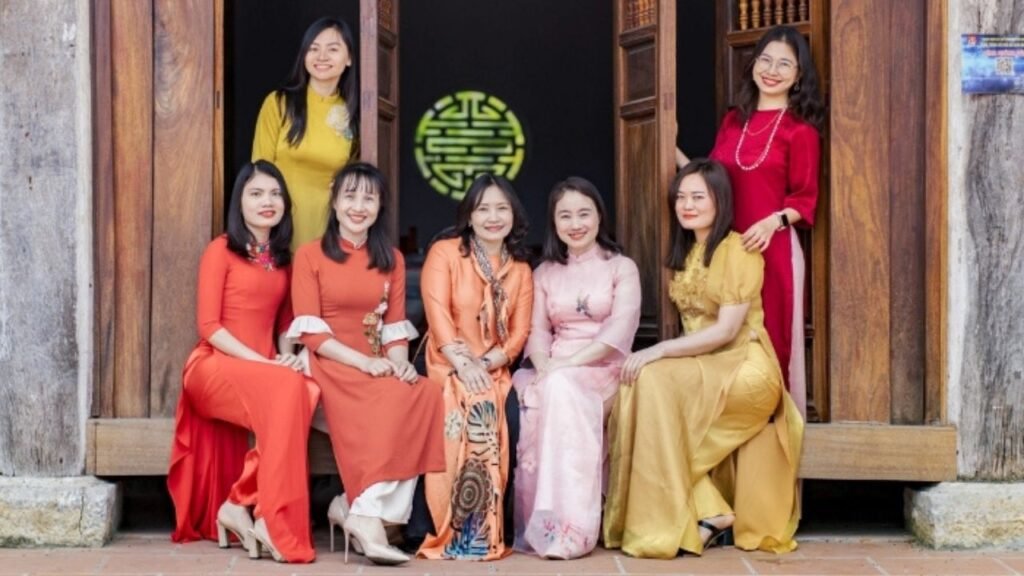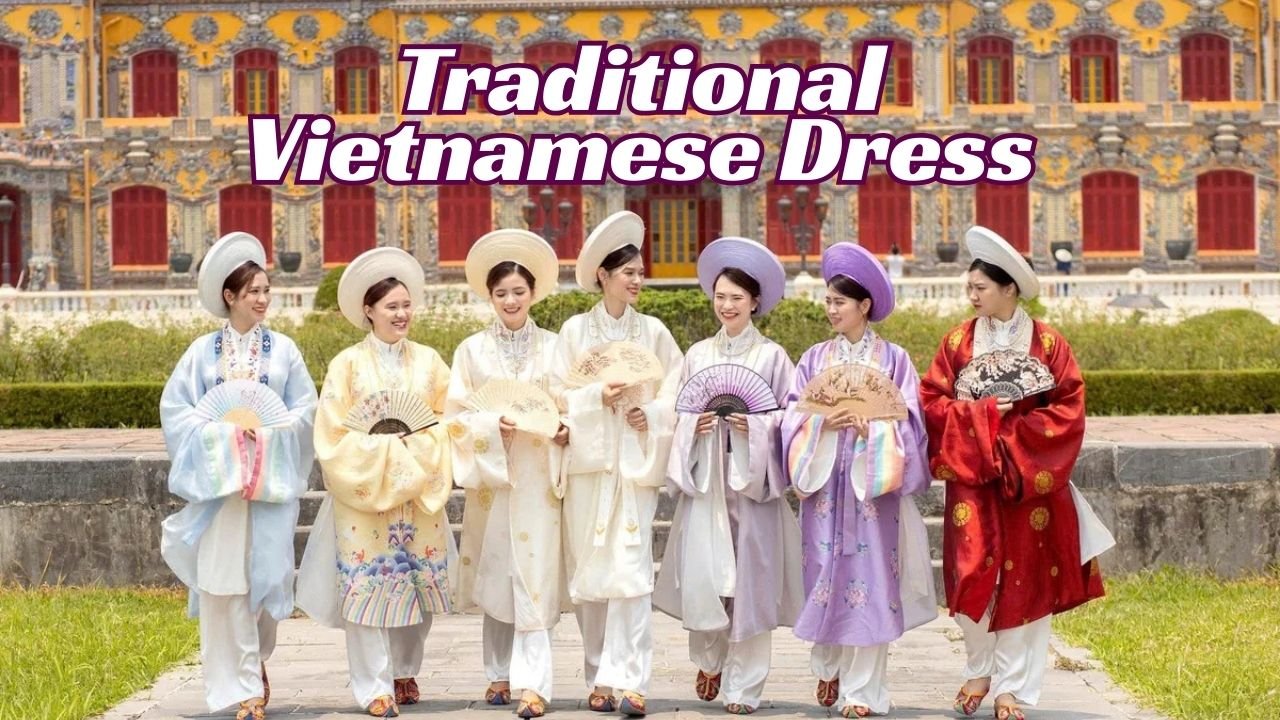Vietnam is a country with a rich cultural history, and its conventional dress displays centuries of records, artistry, and social symbolism. Among the maximum iconic of Vietnamese attire is the Áo Dài, a garment that has transcended time and trends to turn out to be a national symbol of elegance, grace, and identification. This cultural legacy in fabric now not most effective showcases Vietnam’s aesthetic sensibilities however additionally tells the story of its people, records, and evolving fashion traditions.
1. What Is The Traditional Vietnamese Dress?
Traditional Vietnamese dress is a critical a part of the kingdom’s cultural identification, showcasing the concord between records, aesthetics, and daily existence. Over generations, the Vietnamese human beings have evolved a variety of clothes that mirror nearby distinctions, gender roles, social lessons, and ceremonial functions. Prominent traditional outfits include:
- Ao dai: The maximum famous conventional get dressed these days, regarded as Vietnam’s national gown. With its sleek and shape-fitting layout, the ao dai is frequently worn during gala’s, weddings, and formal activities.
- Ao tu than: A traditional garment of Northern Vietnamese ladies in the past, representing hardworking and modest countryside life. Its four-element shape carries symbolic meanings associated with own family and history.
- Ao ba ba: A simple and practical outfit originating from Southern Vietnam, favored for its comfort and simplicity in normal use. It symbolizes the country yet charming beauty of the Southern people.
- Ao Nhat Binh, ao the, ao gam: These clothes are extra ceremonial and have been historically worn in royal courts or throughout special occasions. Ao Nhat Binh become used by imperial women at some stage in the Nguyen dynasty, even as ao The with “khan xep” (conventional turban) is visible in cultural rituals.
2. Historical Origins And Evolution of Traditional Dress
Vietnamese conventional apparel incorporates the legacy of hundreds of years of history. Each dynasty (Ly, Tran, Le, and Nguyen) formed its specific style impacts, obvious in garment structure, fabric, and patterns. During the Ly and Tran dynasties, royal apparel meditated a combination of Buddhist and Chinese court docket styles, emphasizing dignity and formality. In the Le dynasty, dress codes have become stricter, with colours and designs symbolizing social ranks and rituals. The Nguyen dynasty marked a turning factor, whilst the ao dai started to take a greater recognizable form, merging the go-collared “ao giao linh” with Western tailoring affects, in particular at some stage in the colonial length.
Eastern cultures, particularly China, inspired Vietnamese royal clothing through symbols like dragons and phoenixes, even as Cham tradition contributed softer, breathable material structures desirable to tropical climates. In the twentieth century, the ao dai went via current variations, from the “ao tu than” to the “ao ngu than” (5-paneled version), and finally the Le Mur ao dai, redesigned via artist Cat Tuong in the Thirties. Today’s ao dai blends conventional allure with current beauty, becoming a timeless fashion announcement.
Traditional clothes also reflected elegance distinctions: commoners wore realistic ao tu than or ao ba ba; officials donned ceremonial ao gam and ao dai; nobility and royalty were embellished in difficult clothes like Nhat Binh or imperial robes. These distinctions now not handiest signified popularity however additionally reinforced Confucian social hierarchies deeply rooted in Vietnamese tradition.
3. Cultural And Symbolic Meaning
Traditional Vietnamese get dressed is not merely an aesthetic symbol, it embodies profound layers of culture, philosophy, and countrywide identity. The following are key cultural and symbolic components embedded in conventional attire:
- Reflection of traditional Vietnamese virtues: Designs which includes the ao dai, ao tu than, and ao ba ba emphasize modesty, softness, and beauty with out being flamboyant. These capabilities spotlight humility, refinement, and subtle splendor, center values in Vietnamese and broader East Asian societies.
- Symbolism in hues and styles: Every color contains its very own message:
- Red: Symbolizes good fortune, love, and pleasure; frequently utilized in wedding apparel.
- Yellow: Represents royalty and electricity; historically worn inside the royal court docket.
- Blue and inexperienced: Convey calmness and gentleness; regularly associated with nature’s tranquility. Traditional styles consisting of lotuses, bamboo, dragons, and phoenixes convey religious meanings, denoting beauty, nobility, and toughness.
- Presence in literature, art, and intangible heritage: Traditional dress appears significantly in folks poetry, proverbs, Dong Ho woodblock prints, romantic literature, and creative expressions along with folks dances, “cheo” (conventional opera), and “tuong” (classical drama). The picture of a girl in an ao dai or ao tu than has come to be a deeply rooted cultural symbol in the Vietnamese imagination.
- Expression of social and private identity: Clothing displays gender, age, place, social class, and motive (formal, casual, or performative). For example, ao ba ba is commonplace in Southern Vietnam, ao tu than inside the North, and ao Nhat Binh is connected to aristocratic circles and the royal courtroom.
- Symbol of harmony between humans and nature: Decorative motifs often draw inspiration from nature (lotus flowers, bamboo, birds, clouds, water, etc.), not only for their beauty but also to convey a way of life in sync with the natural world. This reflects the Vietnamese spirit of simplicity, purity, and reverence for nature embedded in their cultural philosophy.

4. Where to See And Experience Traditional Vietnamese Dress
In an technology of fast modernization and globalization, Vietnam’s traditional get dressed has now not diminished into the heritage. Instead, it’s far preserved, reimagined, and celebrated throughout various cultural spaces, serving now not simplest as clothing however as a residing vessel of heritage. From museums to gala’s, those clothes offer a tactile connection to history, identification, and artistry.
- Museums retaining the legacy of traditional dress: At the Ao Dai Museum in Ho Chi Minh City, traffic can explore loads of ao dai from distinctive durations, ranging from classic patterns to modern innovations. In Hanoi, the Vietnamese Women’s Museum offers conventional apparel worn by girls across areas and ethnic corporations, from yem and dark skirts to embroidered headscarves, showcasing Vietnam’s cultural range.
- Heritage spaces: In Hoi An Ancient Town, severa boutiques offer condo or made-to-measure ao dai or ao tu than, turning cultural appreciation into a non-public experience. In Hue, Vietnam’s former imperial capital, traditional costumes like ao nhat binh, ao gam, or ao the come to life in royal reenactments, thru court docket track performances, processions, and rituals that immerse the target audience in historic splendor.
- Traditional festivals: Events such as the Ho Chi Minh City Ao Dai Festival, Hue Festival, and the Vietnamese Ethnic Culture Festival in Hanoi’s Dong Mo village highlight conventional get dressed thru fashion indicates, design competitions, and intercultural exchanges. These gala’s not handiest celebrate beauty but foster cultural pride and intergenerational mastering.
5. Fun Facts about Traditional Vietnamese Dress
Beyond its beauty and cultural fee, traditional Vietnamese garb additionally holds many captivating data that no longer every person may realize. Here are some highlights that make ao dai and other traditional clothes in reality stand out:
- Ao dai has been praised globally: Prestigious platforms which include CNN, BBC, Vogue, and National Geographic have named ao dai one of the maximum stunning and graceful conventional clothing inside the international.
- Many faculties nevertheless uphold the subculture of sporting white ao dai on Mondays: In towns like Hue, Hanoi, and Can Tho, this practice displays beauty, field, and recognize for training.
- Ao tu than lives on through traditional performing arts: Though no longer used in every day put on, ao tu than remains a important part of “cheo” (northern folk opera), “quan ho” songs, and cultural dance performances.
- Vietnamese designers bring ao dai to global catwalks: Designers like Cong Tri, Thuy Nguyen, and Adrian Anh Tuan have reinvented ao dai thru high style, putting Vietnamese identification on the worldwide style map.
- International artists wear ao dai to honor Vietnamese subculture: From pageants and film sets to global boards, ao dai has been worn through international celebrities as a image of Eastern elegance and cultural recognize.
- Traditional dress is a part of Vietnam’s intangible heritage projects with UNESCO: Through country wide history submissions, Vietnam is actively operating to have rituals and fairs associated with traditional get dressed diagnosed and guarded by means of UNESCO.
Conclusion
The traditional Vietnamese dress—maximum substantially the Áo Dài—is a residing testomony to Vietnam’s rich cultural legacy. Its flowing traces, stylish cloth, and intricate designs capture the country’s history, artistry, and societal values. While the get dressed has evolved to accommodate current tastes, it remains a effective symbol of countrywide pleasure and identification. Through the Áo Dài, Vietnam continues to celebrate its background, ensuring that its cultural memories are exceeded down with each sew, every fold, and every graceful motion of the wearer.
